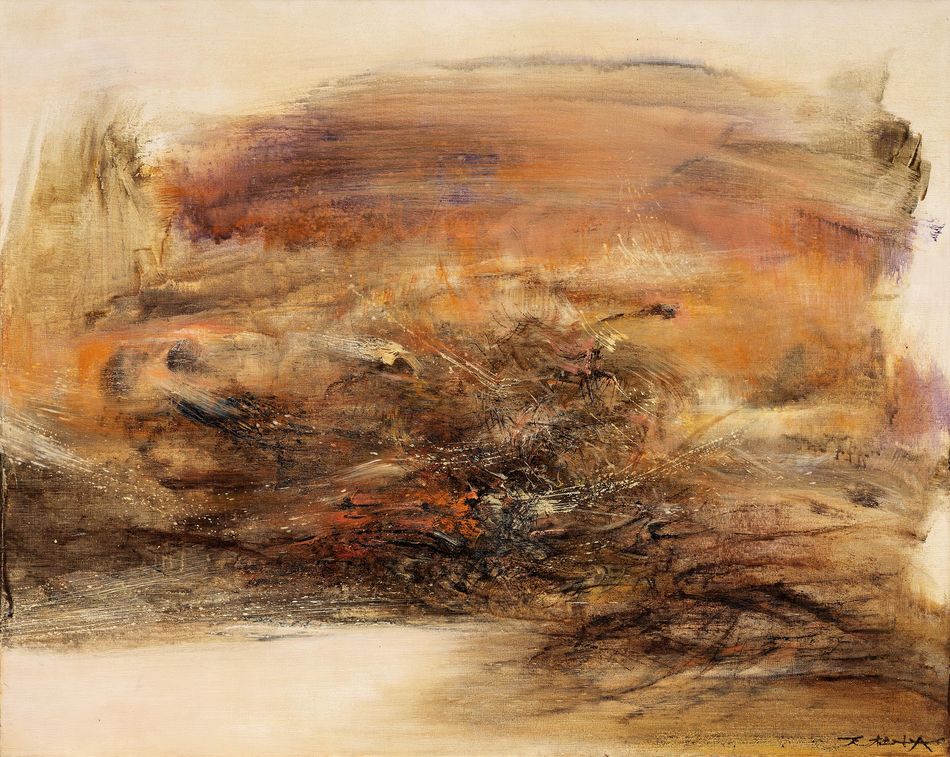

Estimate
TWD 55,000,000-75,000,000
HKD 12,972,000-17,689,000
USD 1,670,200-2,277,600
CNY 12,088,000-16,484,000
Sold Price
TWD 58,560,000
HKD 15,329,843
USD 1,957,874
CNY 14,076,923
Signature
Signed reverse ZAO in French, titled 1.6.65 and inscribed Pour
Paule-Marie et André Chastel. Très amicalement Zao Wou-ki
PROVENANCE
Collection of art historians, Paule-Marie and André Chastel, France
Artcurial Auction, Paris, July 01, 2003, lot 503
Sotheby’s, Hong Kong, October 24, 2005, lot 774
Acquired from the above by the present owner
This lot is referenced in the archive of the Fondation Zao Wou ki and will be included in the second part of artist’s catalogue raisonné under the number P-0489 prepared by Fondation Zao Wou-ki
+ OVERVIEW
beginning his artistic career in France. Influenced bythe dominant Western European art movements of
the time, Zao entered a period of self-exploration.
Between 1949 and 1950, many of his works were
already showing the influence of Paul Klee. In the
1960s, the artist developed his signature horizontal
seascape compositions, marked by grandeur and
vitality. These works reflect a profound synthesis
of years of artistic reflection and the emergence
of a renewed creative energy. Having studied
music for six years, Zao Wou-Ki developed a keen
sensitivity to light sources and space, as well as an
appreciation for the abstract
qualities of music, which he
cleverly linked together in
his art. Taiwanese art critic
Du Ruozhou once praised
him, stating: "The 'Chinese
space' and the 'Western light'
are among Zao Wou-Ki's
remarkable achievements in
art." He continually merged
the potentials of both
cultures, using a modern
vocabulary of expression
that not only allowed for a
spiritual journey but also
created an entirely new visual
world.Zao Wou-Ki's "Hurricane period" series remains
highly sought after by collectors to this day. From
1960 to 1965, he held solo exhibitions at the
influential and legendary Galerie de France in Paris
and Kootz Gallery in New York, and was invited to
exhibit at international museums. Zao Wou-Ki once
described himself during that time: "Those ten
years were a time of full-speed progress, like driving
a high-speed car."
The most prominent feature of Zao Wou-Ki's "Hurricane period" works is their grandiose
momentum, with tightly structured compositions
and an overwhelming sense of power. Zao
skillfully integrates the strengths of Eastern and
Western artistic color and line techniques, truly
creating something unparalleled in the history of
art. In particular, the artist's heartfelt and lyrical
expressions are conveyed through an indescribable
and ever-changing brushstroke technique, layering
into a vast and profound space that is both broad
and continuous. Upon close inspection, the lines
are drawn like delicate
gold, deconstructed yet
full of force, with strong,
sharp brushwork that is at
times exhilarating and at
other times reminiscent of
intertwined mountains and
rivers. Viewers are invited to
follow the boundless energy
of the world and feel a sense
of awe at the infinitesimal
part we play in the grand
scheme of nature.The artwork 1.6.65 belongs
to Zao Wou-Ki's "Hurricane
period" and features a
medium-sized, iconic horizontal composition, fully showcasing the
representative characteristics of the artist's work
during this period. The background is based on a
light ochre tone, continuing the calm brown hues
that began in 1964, complemented by fine layers of
orange, white, purple, black, and red, meticulously
arranged with delicate brushwork. In contrast to the
earlier works that featured strong color contrasts,
1.6.65 demonstrates a more restrained use of color,
focusing on the artist's exploration of the delicate
balance between brushwork and composition.The glow of twilight sweeps across the upper part of the canvas , with brushstrokes soaring like an eagle, flying with swift elegance and energy. As the strokes reach the center of the composition, the brushwork tightens, creating a rhythm that feels as if a celestial being is soaring through the air. The entire work is filled with strength and dynamic layers of movement. Whether in the brushwork or the color structure, there is a perfect balance of firmness and softness, expanding with grace and unleashing the artist's fullest creative energy.According to the artist's own inscription on the reverse of 1.6.65, the work originally belonged to the private collection of the esteemed French art historian André Chastel (1912–1990) and his wife Paule-Marie Grand Chastel (1914–2006). André Chastel, renowned for his extensive research on the Italian Renaissance, was elected to the Académie Française in 1975. While teaching at the Sorbonne in Paris, he was deeply committed to nurturing art historians and future scholars. In 1959, he
founded the Centre de recherche sur l’histoire de l'architecture moderne (CRHAM), which has since evolved into the Centre André Chastel—today one of France's leading institutions for the study of European cultural heritage and Western art history.
Chastel frequently visited contemporary artists and developed deep friendship with figures such as André Masson and Za Wou-Ki.Zao Wou-Ki was born in Beijing in 1921 and passed away in Switzerland in 2013. Throughout his long life of 93 years, he spent the majority of it in France. His Chinese heritage and cultural legacy, combined with his French nationality and artistic training, allowed him to collaborate closely with major Western galleries for over half a century. He became arepresentative artist of the fusion of Eastern and Western cultures, and his international popularity is well-deserved. With a wealthy family background
and extensive connections, his artistic career was relatively smooth. Having spent most of his life in Europe and gained fame abroad, Zao Wou Ki holds a distinguished position, and his artistic achievements can be considered a shining example
for the Chinese community. In recognition of his artistic achievements and
contributions, Zao Wou-Ki was awarded several prestigious. In December 2002, he became the second Chinese painter, after Chu Teh-Chun, to be elected as a lifelong member of the French Academy of Fine Arts. The title of lifelong member
of the French Academy of Fine Arts is the highest honor awarded by the French government to artists.
Modern & Contemporary Art
Ravenel Spring Auction 2025 Taipei
Sunday, June 1, 2025, 2:00pm
